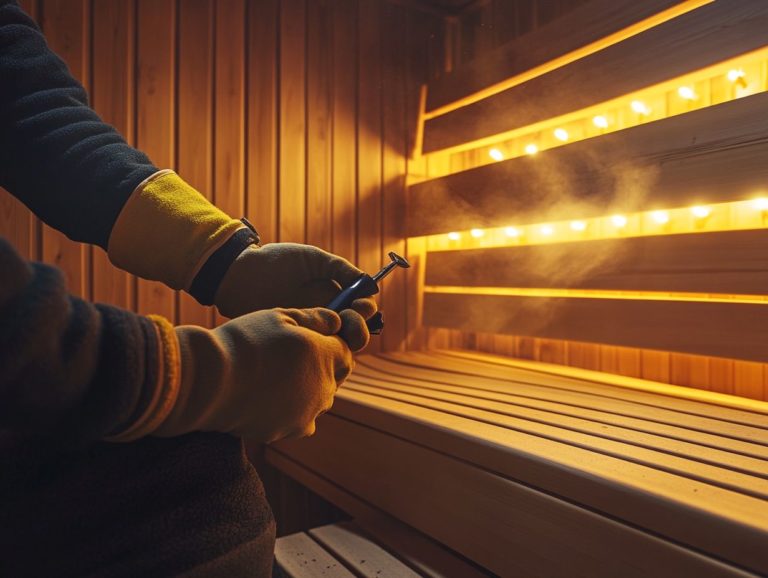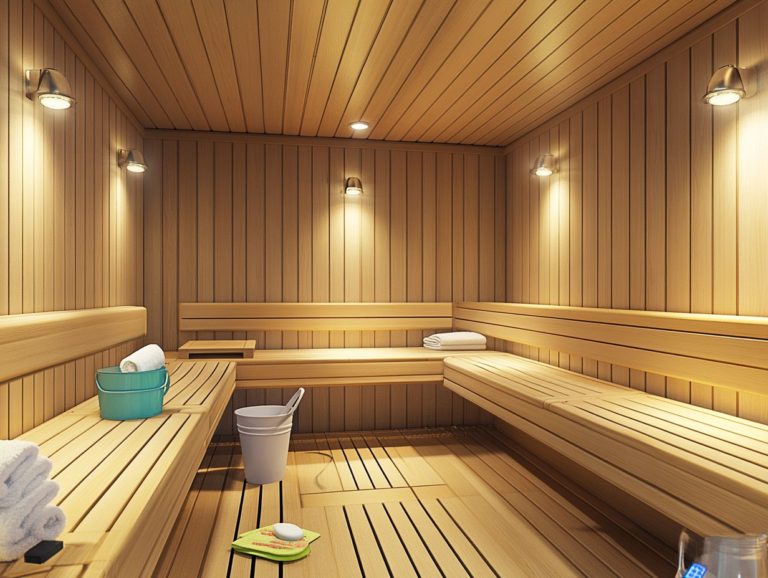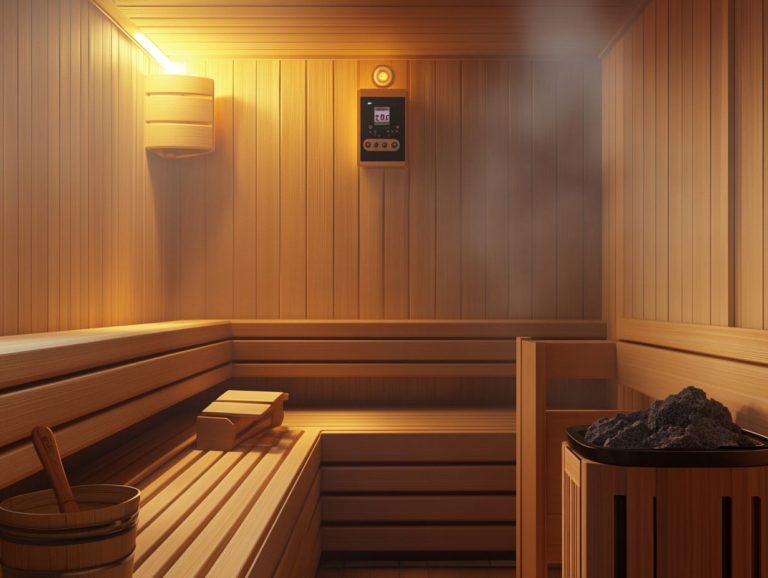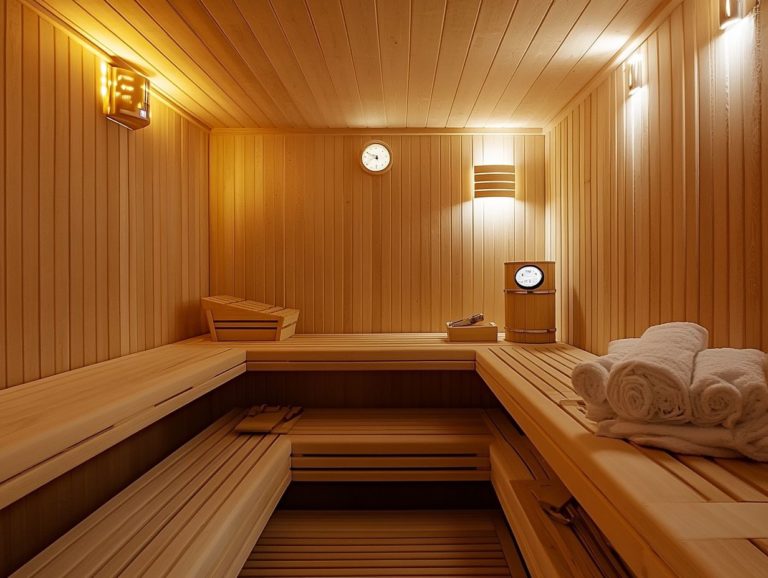How to Maintain the Temperature in Your Sauna
Saunas provide an unparalleled combination of relaxation and health benefits. Hitting the optimal temperature is essential for your ideal experience.
Get ready to explore the recommended temperature range for saunas, along with the various factors that can influence it, such as room size and heating methods.
You ll uncover effective techniques for maintaining that perfect heat. Tips on adjusting ventilation and utilizing a thermometer are vital for proper sauna maintenance.
Learn about the advantages of achieving the right sauna temperature and common pitfalls to avoid. This way, you can enjoy a truly rejuvenating session.
Contents
Key Takeaways:
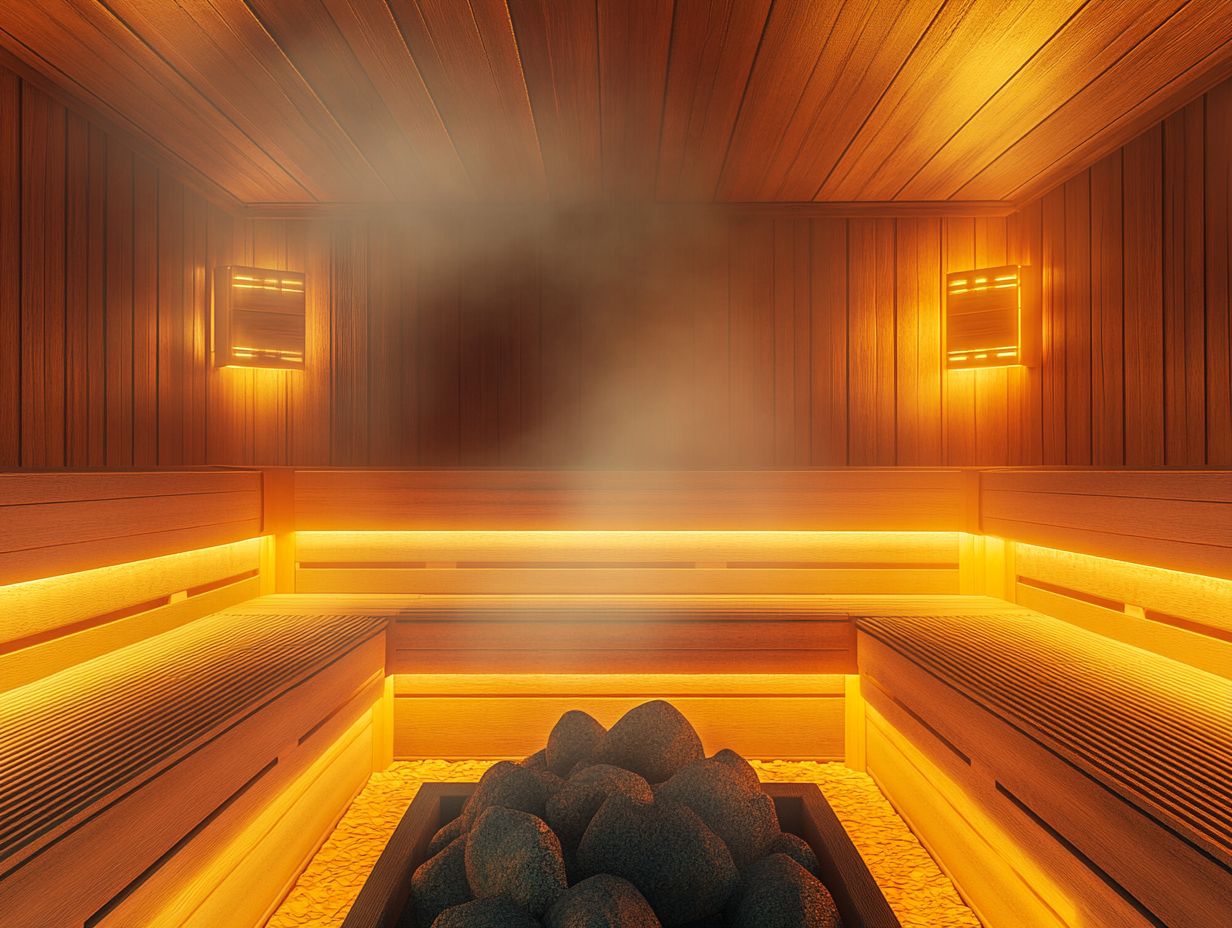
- Keep your sauna temperature within the recommended range of 150-190 F to ensure a safe and enjoyable experience.
- Factors such as room size, insulation, and heating methods can greatly affect the temperature in your sauna.
- To maintain the temperature, adjust ventilation, add water to the rocks, and use a thermometer to monitor and regulate heat levels.
Understanding Sauna Temperature
Understanding sauna temperature is essential for crafting a comfortable and effective sauna experience. This applies whether you re indulging in a traditional sauna, an infrared sauna (which uses light to create heat), or a Finnish sauna. The optimal temperature typically falls between 150 F and 195 F (65 C to 90 C). Mastering this range can significantly enhance your overall health and wellbeing.
It s important to consider factors like humidity levels and your body s temperature. These elements play a crucial role in influencing your comfort and maximizing the sauna’s health benefits.
Recommended Temperature Range
The ideal temperature range for your sauna sessions generally spans from 150 F to 195 F (65 C to 90 C). This range can be tailored to your personal preferences and the type of sauna you choose.
If you opt for a traditional sauna, you’ll find it often operates at the higher end of this spectrum. This envelops you in a steamy environment that encourages deep sweating. On the other hand, if infrared saunas catch your eye, they typically offer a more gentle heat around 120 F to 150 F (49 C to 65 C). To maintain your sauna and ensure it stays in optimal condition, consider keeping your sauna dry, which allows for longer, more comfortable sessions without overwhelming discomfort.
Finnish saunas, renowned for their unique ambiance and health benefits, provide a delightful balance of temperature and humidity. This caters to a diverse range of individuals. Each type of sauna will influence not only the duration of your sessions, usually lasting between 15 to 30 minutes, but also your hydration needs. To ensure you’re getting the most out of your experience, consider maintaining your sauna for optimal performance.
Keeping your hydration in check is essential to fully enjoy the health benefits while minimizing any potential risks. Staying hydrated helps prevent discomfort and enhances these benefits.
Factors Affecting Sauna Temperature
Several factors influence the temperature of your sauna, including the size of the room, the quality of insulation, and the heating methods you choose.
Whether you opt for electric heaters, infrared heaters, or traditional wood-burning stoves, each method plays a crucial role in shaping the overall atmosphere of your sauna experience.
Room Size and Insulation
The size of your sauna room and its insulation are crucial for maintaining the ideal temperature. These factors directly influence how heat is retained and distributed throughout the space, which is key for optimum warmth for all age groups.
When you think about how these elements come together, it s evident that larger rooms may demand more energy to heat effectively. This can result in uneven temperatures if not managed correctly. Proper insulation acts as a safeguard, preventing heat from escaping and bolstering your energy efficiency.
Different sauna types, whether traditional steam or infrared, have unique insulation requirements due to their specific heating methods. Engaging in regular maintenance, such as inspecting for air leaks and ensuring that panels remain in good condition, can greatly enhance insulation performance. For homeowners, following sauna maintenance essential tips is crucial. This attention to detail ultimately creates a more consistent and enjoyable sauna experience for you.
Heating Methods
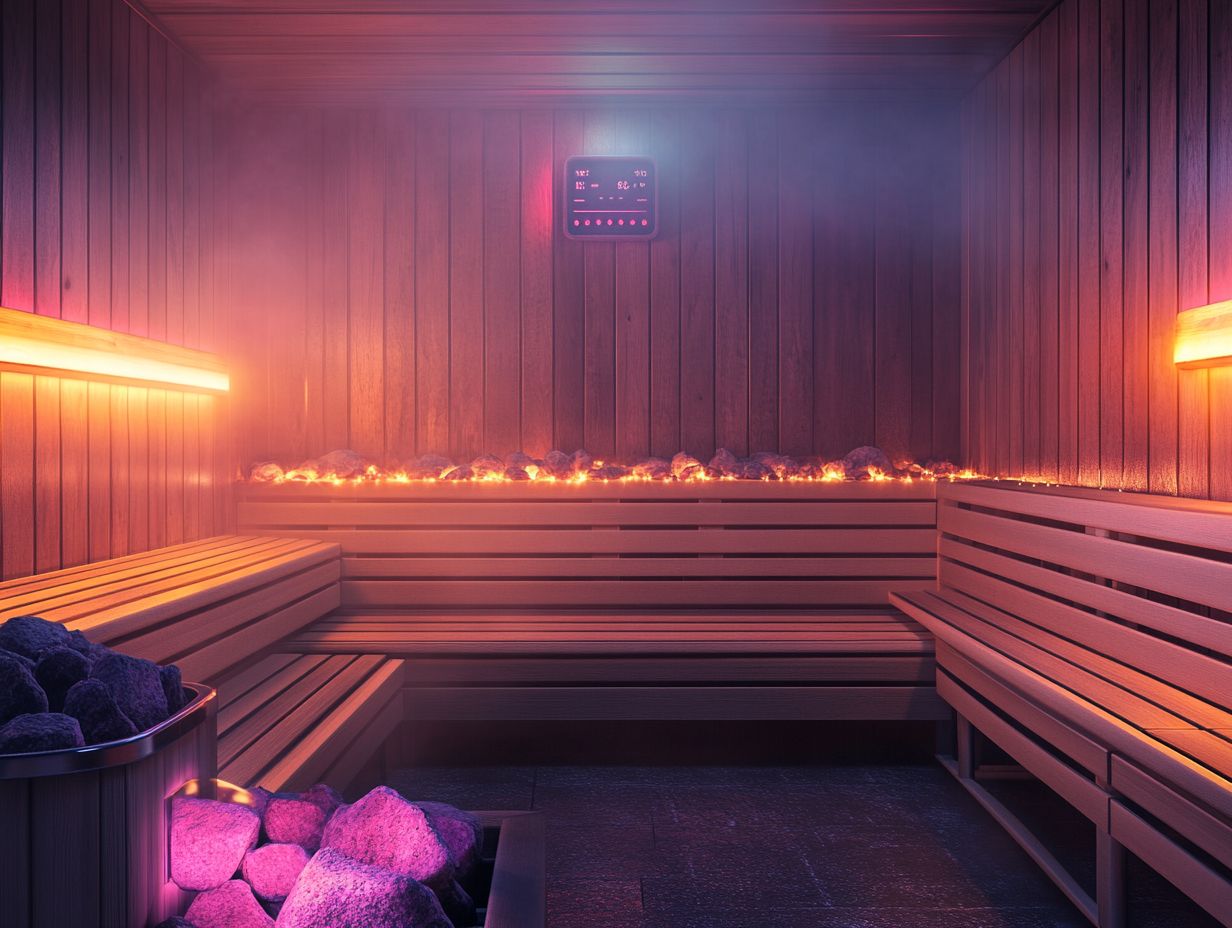
The choice of heating method whether it’s electric heaters, infrared heaters, or wood-burning stoves plays an important part in how quickly your sauna reaches the desired temperature and shapes your overall experience.
Electric heaters are the go-to for quick heating and user-friendliness. They keep the space comfortable, which many find highly convenient.
On the flip side, infrared heaters offer a gentle warmth that penetrates deeper into your skin while keeping humidity levels lower. This enhances comfort for those longer sessions.
Meanwhile, wood-burning stoves deliver a classic, rustic ambiance, though they do require a bit more hands-on maintenance. Each of these methods not only influences the heat profile of the room but also affects humidity, which is crucial for anyone aiming for optimal detoxification and relaxation.
With a variety of health benefits associated with sauna use, selecting the right heating method is essential for reaching your personal wellness goals.
Methods for Maintaining Sauna Temperature
Ready to enjoy your sauna to the fullest? To maintain a consistent sauna temperature, you must employ effective temperature control methods. This includes adjusting airflow management, adding water to the sauna stones, and utilizing a thermometer to monitor the conditions.
Each step plays a crucial role in ensuring a comfortable and rejuvenating experience.
Adjusting Ventilation
Adjusting airflow management is essential for maintaining the perfect sauna atmosphere, ensuring that heat and humidity levels are balanced for an optimal experience, particularly in wet saunas.
Managing ventilation helps achieve a uniform temperature distribution, enhancing your comfort, while also encouraging airflow that alleviates feelings of stuffiness. Different ventilation strategies offer varying results; for example, an exhaust system can efficiently draw out excess heat and humidity, creating a refreshing environment.
A balanced intake and exhaust setup promotes even air circulation throughout the space. Poor ventilation can cause health issues such as respiratory discomfort or overheating. Ultimately, choosing the right approach can significantly enhance your wellness benefits. For optimal maintenance, learn how to schedule sauna maintenance services to ensure a relaxing and enjoyable sauna experience.
Adding Water to the Rocks
Adding water to the sauna rocks transforms your experience, creating clouds of steam that elevate the perceived warmth. This practice is traditional in many sauna cultures.
This seemingly simple act boosts humidity and plays a vital role in your overall relaxation and enjoyment. As the moisture fills the air, it cultivates a richer environment, encouraging deeper and more effective sweating, one of the key benefits of your sauna session. To ensure optimal performance, consider following these tips for maintaining your sauna’s electronics.
In many cultures, it s a time-honored practice to splash water on heated stones, creating bursts of steam that invite you to inhale the soothing warm vapors. This ritual heightens your sensory experience and promotes detoxification and improved circulation, turning each sauna visit into not just a leisurely escape but a valuable health practice.
Using a Thermometer
Using a thermometer measures temperature, ensuring you enjoy a safe and comfortable experience during your sauna sessions.
These devices deliver accurate readings of your environment and help you maintain the optimal conditions that contribute to relaxation and various health benefits. Saunas can become risky if the temperature veers too high or too low, leading to overheating or an ineffective detoxifying experience.
Common mistakes include failing to calibrate the thermometer properly or placing it in an unsuitable location, which can result in misleading readings. Don’t risk your comfort; check the thermometer regularly! By monitoring and adjusting with a reliable thermometer, you can prevent discomfort and enhance your overall sauna experience. For optimal results, consider professional sauna maintenance to fully appreciate the therapeutic effects it offers.
Benefits of Maintaining Proper Sauna Temperature
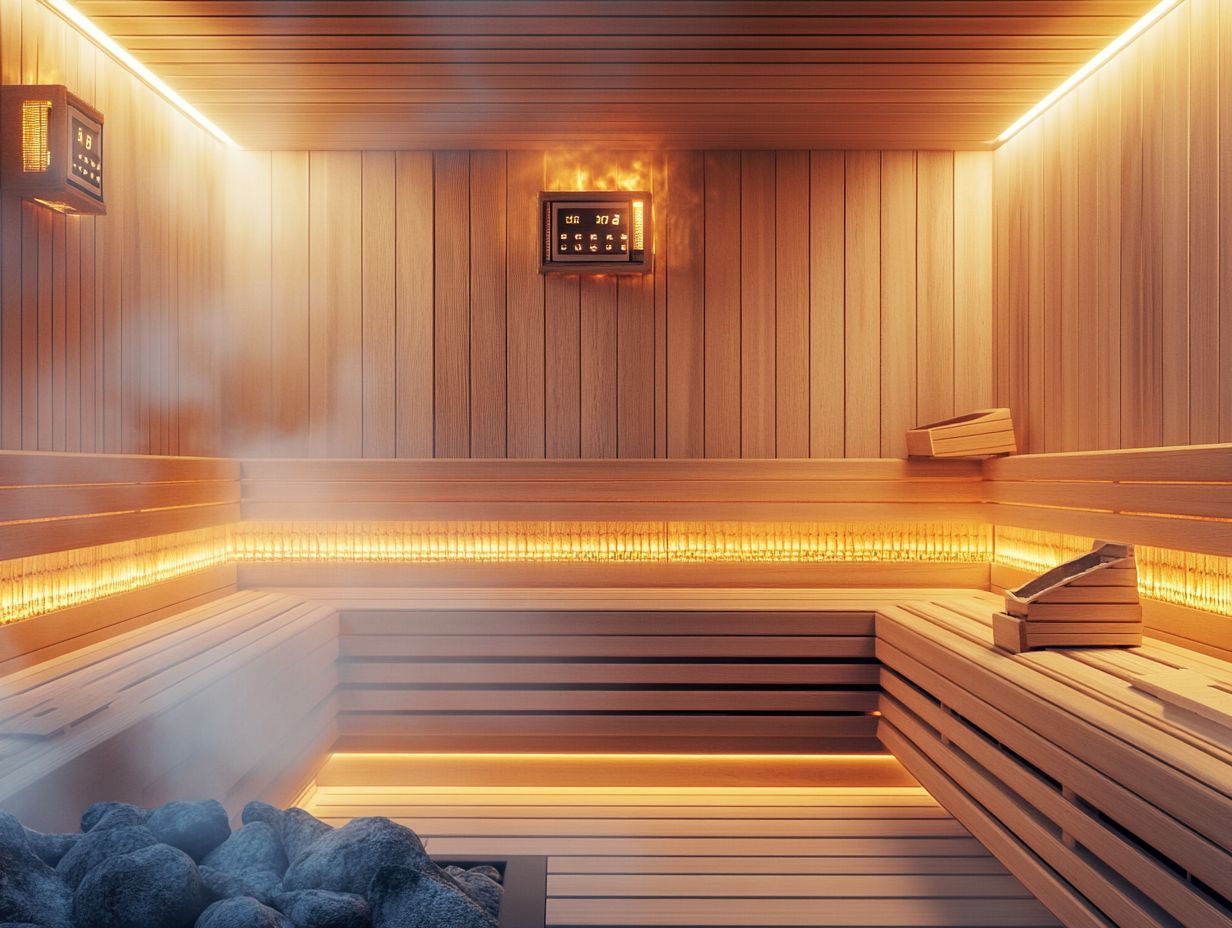
Maintaining the right sauna temperature is essential for achieving an optimal sauna experience. This attention to detail unlocks a wealth of health benefits for you, including improved blood circulation, enhanced relaxation, and the effective benefits of sweating. Embracing the perfect temperature allows you to reap these rewards, transforming your sauna sessions into a truly rejuvenating ritual.
Optimal Sauna Experience
An optimal sauna experience revolves around maintaining the perfect temperature. This significantly enhances your relaxation and maximizes the overall benefits of the sauna.
When you achieve that ideal warmth, it promotes muscle relaxation and encourages the release of endorphins, giving you a delightful mood boost. Setting the temperature between 150 F and 195 F taps into heightened cardiovascular benefits, including improved circulation.
Many sauna enthusiasts enhance their experience by adding aromatherapy oils or natural herbal infusions during their sessions. The soothing scents deepen your relaxation and help release tension.
Engaging in practices like switching between hot sauna sessions and cold plunges invigorates your body and sharpens your mental clarity, amplifying the advantages of this time-honored wellness ritual.
Health Benefits
The health benefits of maintaining the proper sauna temperature are impressive. Regular sauna sessions enhance sweating, improve blood circulation, and provide heat therapy that positively influences your core body temperature.
Regular sauna use can boost your cardiovascular function, often leading to lower blood pressure and a reduced risk of heart disease. Many users report feeling more refreshed and healthier, enjoying the detoxification effects of sweating, which promotes toxin elimination, contributing to overall skin health and vitality.
However, it’s crucial to recognize that certain health conditions like heart ailments or respiratory issues may require caution. Always consult with a healthcare provider before stepping into that steamy sanctuary. Many users experiencing muscle soreness or tension find that post-workout sauna sessions significantly ease their discomfort, showcasing the therapeutic nature of this age-old practice.
Common Mistakes to Avoid
Avoiding common mistakes, such as overheating or underheating the sauna, is crucial for ensuring your safety and maximizing your experience. By maintaining the right temperature, you enhance your enjoyment and protect your wellbeing.
Overheating the Sauna
Overheating the sauna can lead to heat stress, jeopardizing your safety and diminishing your overall enjoyment. Symptoms like dizziness, excessive sweating, and dehydration can hinder your experience and pose significant health risks. Prolonged exposure to high temperatures could lead to heat exhaustion or, in severe cases, heat stroke conditions demanding immediate medical attention.
Pay close attention to how your body responds to the heat to maximize your sauna enjoyment. Follow established sauna guidelines, including limiting your time inside and ensuring you hydrate adequately before and after your session.
By doing so, you can enjoy a safe and enriching sauna experience while reaping its potential health benefits.
Ready to experience the benefits of a properly heated sauna? Discover how a few minutes in the right temperature can transform your health and wellness journey! Don’t forget to check out these sauna maintenance tips for busy individuals to keep your sauna in great shape.
Underheating the Sauna
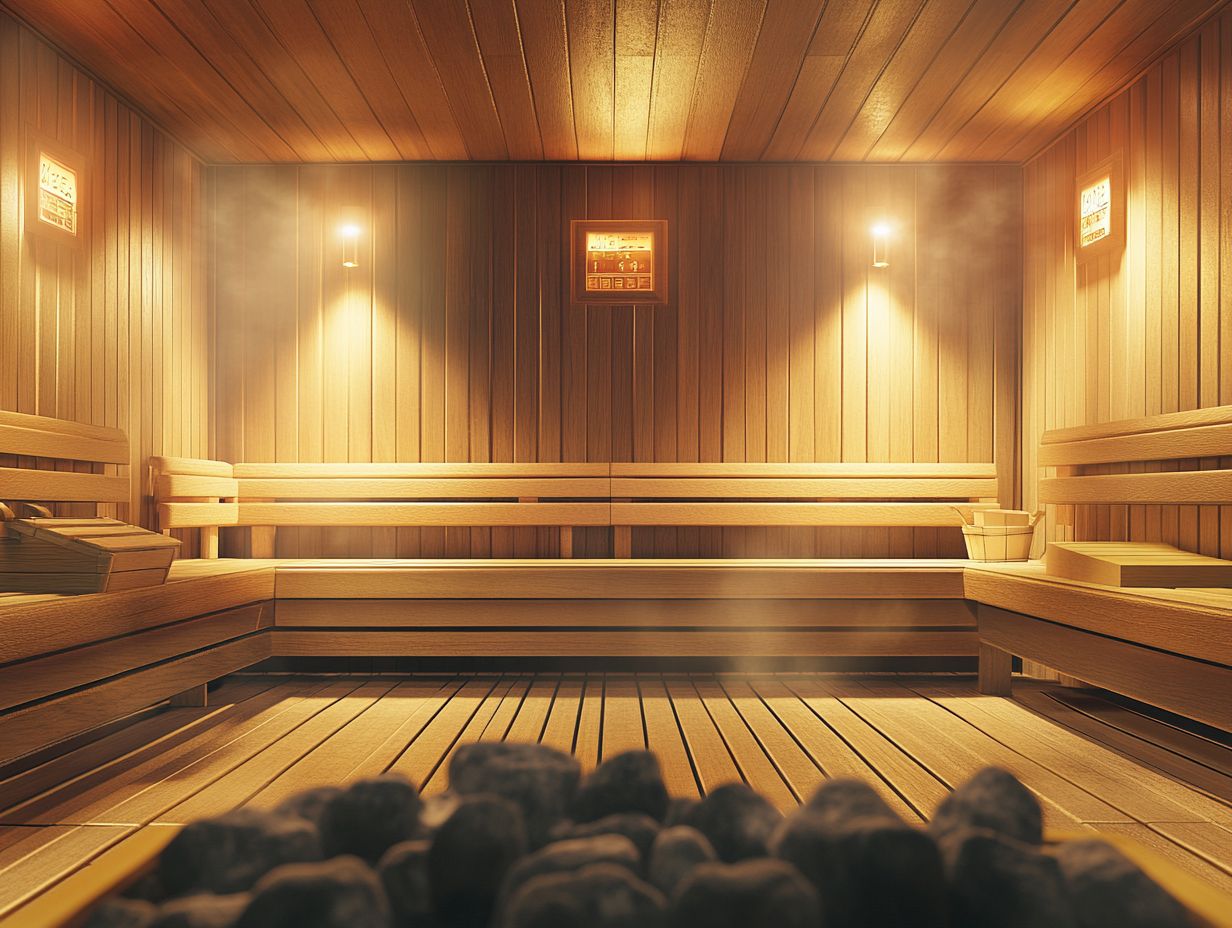
Underheating the sauna can turn a relaxing experience into one of discomfort. You may end up feeling unsatisfied and miss out on the benefits.
When temperatures fall below the ideal range, you might struggle to relax. This can affect both your physical comfort and the mental peace you want during your sessions.
You may find yourself missing out on therapeutic effects like improved circulation and detoxification, which are essential for fully enjoying the sauna experience.
To remedy this, it’s crucial to maintain a consistent temperature between 150 F and 195 F. For more tips on ensuring your sauna is well-cared for, check out how to maintain your sauna’s warranty. This way, everyone can enjoy the rich rewards of a well-heated sauna, regardless of their personal preferences.
Frequently Asked Questions
What is the ideal temperature for a sauna?
The ideal temperature for a sauna is typically between 150-190 degrees Fahrenheit.
How do I maintain the temperature in my sauna?
To maintain the temperature in your sauna, make sure to properly cover the walls and ceiling, use a heater with a thermostat, and regularly check and adjust the temperature as needed.
What are some common mistakes that can cause the temperature in my sauna to fluctuate?
Common mistakes that can cause temperature fluctuations include leaving the door open for too long, using the wrong type of heater, or not properly covering the sauna.
Can I use a thermometer to monitor the temperature in my sauna?
Yes, using a thermometer is an effective way to monitor the temperature in your sauna and make adjustments as needed.
How often should I check the temperature in my sauna?
Check the temperature every 10-15 minutes to keep the sauna just right and avoid discomfort.
Is it normal for the temperature in my sauna to fluctuate?
Some temperature fluctuation is normal in a sauna. However, if you notice drastic changes or difficulty maintaining a consistent temperature, there may be an issue with the insulation or heater.

